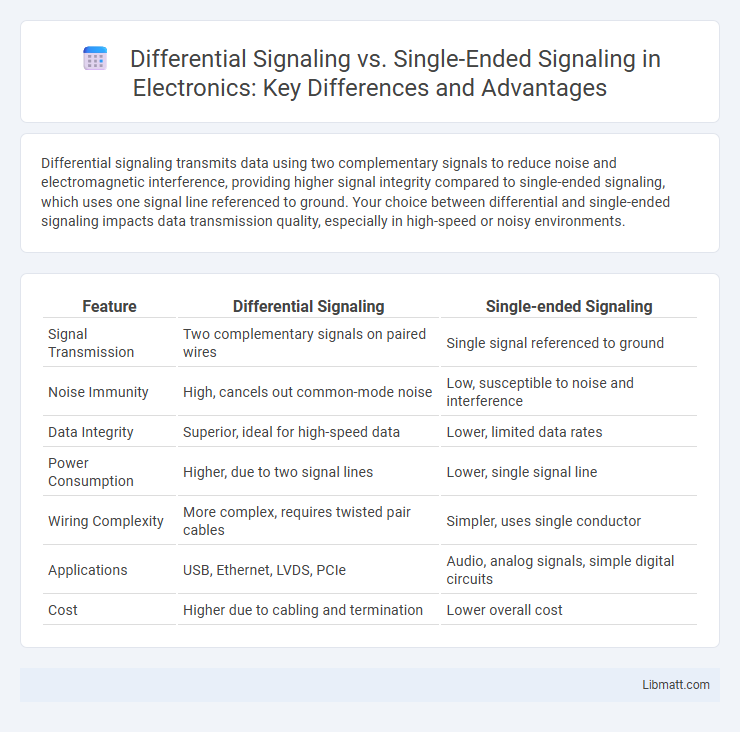Differential signaling transmits data using two complementary signals to reduce noise and electromagnetic interference, providing higher signal integrity compared to single-ended signaling, which uses one signal line referenced to ground. Your choice between differential and single-ended signaling impacts data transmission quality, especially in high-speed or noisy environments.
Table of Comparison
| Feature | Differential Signaling | Single-ended Signaling |
|---|---|---|
| Signal Transmission | Two complementary signals on paired wires | Single signal referenced to ground |
| Noise Immunity | High, cancels out common-mode noise | Low, susceptible to noise and interference |
| Data Integrity | Superior, ideal for high-speed data | Lower, limited data rates |
| Power Consumption | Higher, due to two signal lines | Lower, single signal line |
| Wiring Complexity | More complex, requires twisted pair cables | Simpler, uses single conductor |
| Applications | USB, Ethernet, LVDS, PCIe | Audio, analog signals, simple digital circuits |
| Cost | Higher due to cabling and termination | Lower overall cost |
Introduction to Differential Signaling and Single-ended Signaling
Differential signaling transmits data using two complementary voltage signals, enhancing noise immunity and signal integrity, especially in high-speed digital and analog communication systems. Single-ended signaling sends data by referencing a single voltage signal to a common ground, making it simpler but more prone to noise and electromagnetic interference. Applications in environments with high electromagnetic interference often favor differential signaling for its superior noise rejection compared to single-ended signaling.
Fundamental Concepts: What Are Differential and Single-ended Signals?
Differential signaling uses two complementary voltage lines to transmit data, improving noise immunity and reducing electromagnetic interference (EMI) by measuring the voltage difference between the lines. Single-ended signaling transmits data through a single voltage line with a shared reference ground, making it more susceptible to noise and signal degradation over long distances. Understanding these fundamental concepts helps optimize your circuit design for signal integrity and reliable communication.
Working Principle of Differential Signaling
Differential signaling transmits electrical signals using two complementary voltage lines, where one carries the positive signal and the other carries the inverse, enabling the receiver to measure the voltage difference between them. This method effectively cancels out common-mode noise and electromagnetic interference, improving signal integrity over longer distances or in electrically noisy environments. The contrasting voltages increase noise immunity and reduce signal degradation compared to single-ended signaling, which uses a single voltage reference against ground.
How Single-ended Signaling Operates
Single-ended signaling operates by transmitting voltage levels referenced to a common ground, where the signal voltage is measured between the signal line and ground. This method is simpler and cost-effective but is more susceptible to electromagnetic interference (EMI) and noise, which can degrade signal integrity over longer distances or in electrically noisy environments. The single-ended approach is commonly used in low-speed or short-distance communication applications, such as TTL and CMOS logic circuits.
Key Differences Between Differential and Single-ended Signaling
Differential signaling transmits two complementary signals on paired wires, enhancing noise immunity and allowing higher data rates compared to single-ended signaling, which sends a single signal referenced to ground. This key difference results in reduced electromagnetic interference and improved signal integrity in differential setups, making them ideal for environments with high electrical noise. Your choice between these methods impacts the overall system performance, especially in high-speed communication and precision measurement applications.
Advantages of Differential Signaling
Differential signaling offers significant advantages such as improved noise immunity and reduced electromagnetic interference by transmitting two opposite signals along a pair of wires, allowing receivers to reject common-mode noise. This method enhances signal integrity over longer distances and in electrically noisy environments, making it ideal for high-speed data communication. Your systems benefit from increased reliability and lower error rates when using differential signaling compared to single-ended signaling.
Limitations of Differential Signaling
Differential signaling faces limitations including increased complexity and cost due to the requirement of two conductors per signal, which can complicate PCB layout and increase material usage. It can also be more susceptible to common-mode interference if the differential pair is not perfectly balanced or matched in impedance. Furthermore, differential signaling demands more sophisticated receiver circuits to detect voltage differences accurately, which can increase power consumption and design complexity.
Applications of Single-ended and Differential Signaling
Single-ended signaling is commonly used in low-speed and short-distance applications such as audio signals, microcontroller GPIOs, and simple sensor data transmission due to its simplicity and cost-effectiveness. Differential signaling excels in high-speed, long-distance, and noise-prone environments like USB, Ethernet, HDMI, and automotive communication systems by providing better noise immunity and signal integrity. When choosing Your signaling method, consider the application's required speed, distance, and electromagnetic interference conditions to ensure optimal performance.
Choosing Between Differential and Single-ended Signaling
Choosing between differential and single-ended signaling depends on your application's noise environment and signal integrity needs. Differential signaling offers superior noise immunity and better performance over long distances by transmitting complementary signals, making it ideal for high-speed or electrically noisy environments. Single-ended signaling is simpler and cost-effective for short distances or low-frequency applications where noise is less of a concern.
Summary and Future Trends in Signal Transmission
Differential signaling offers superior noise immunity and reduced electromagnetic interference compared to single-ended signaling, making it essential for high-speed and long-distance data transmission. Future trends emphasize increased adoption of differential pairs in advanced communication systems, driven by the demand for higher data rates and improved signal integrity. You can expect further integration of AI-driven signal optimization techniques to enhance differential signaling efficiency and reliability in emerging technologies.
Differential Signaling vs Single-ended Infographic

 libmatt.com
libmatt.com